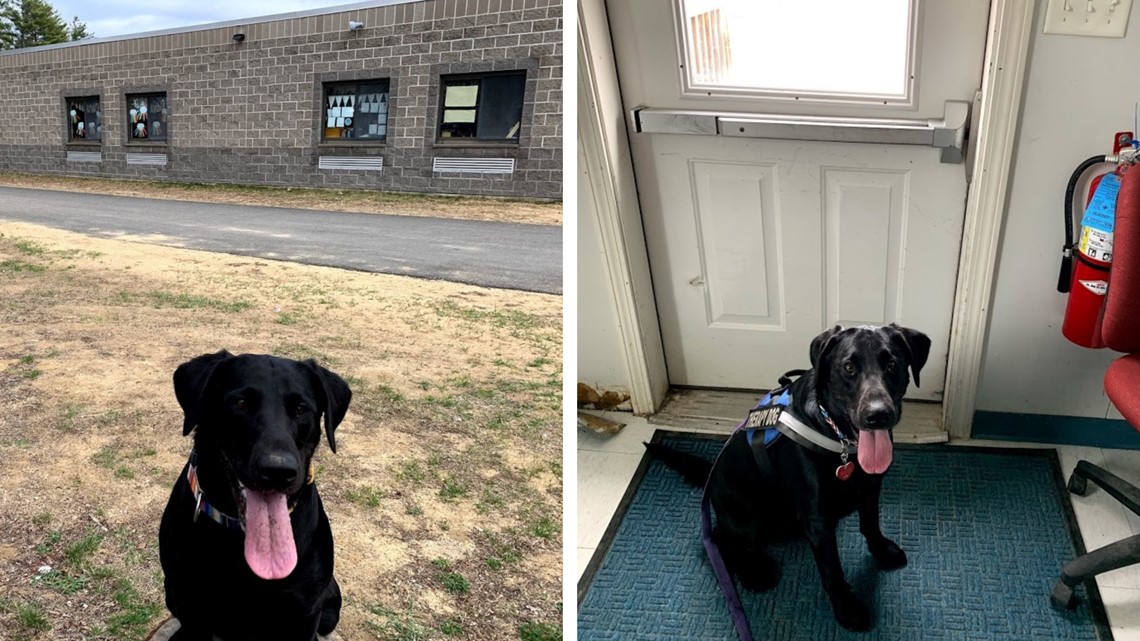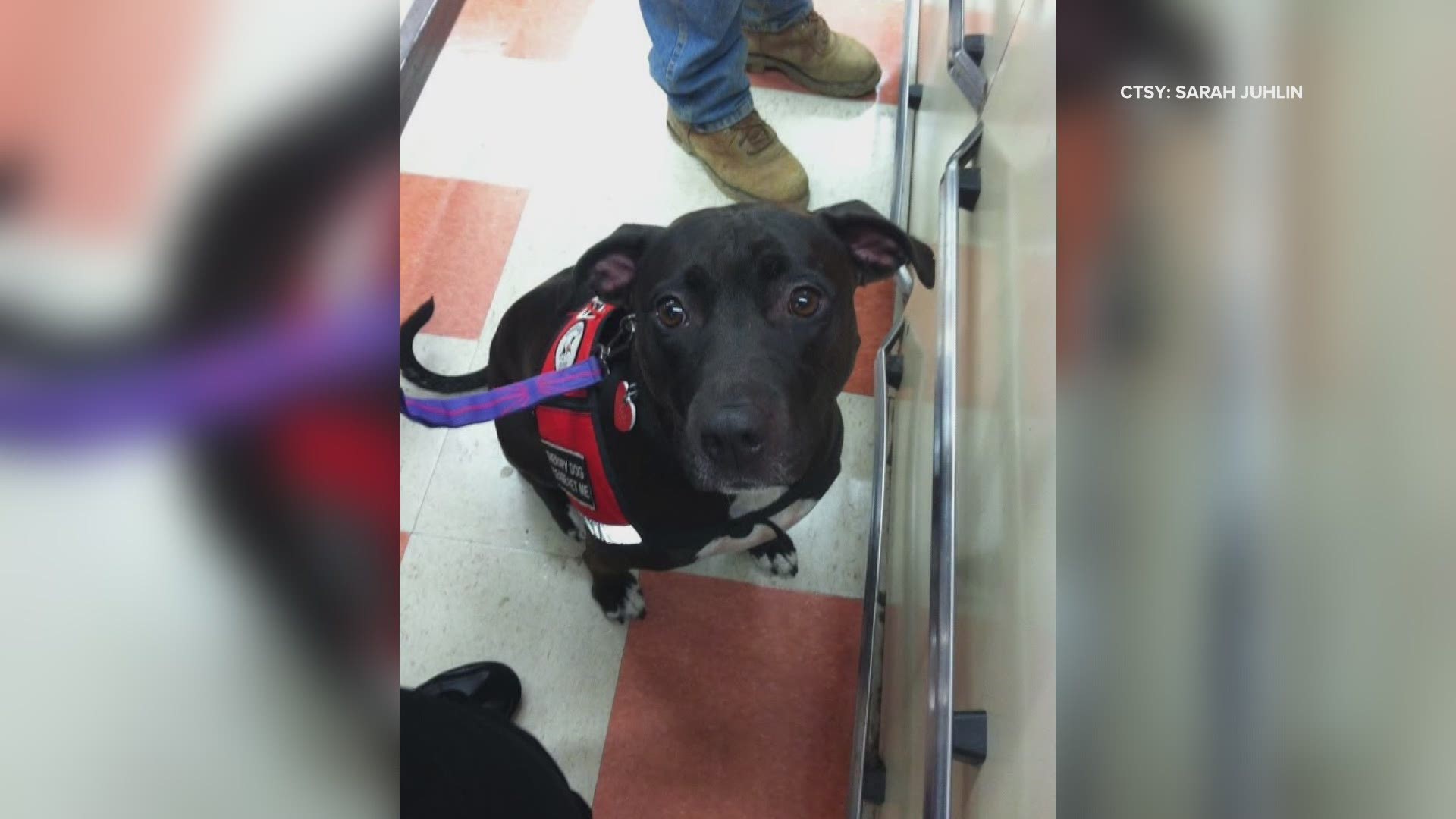BRUNSWICK, Maine — Among many losses experienced at hospitals and long-term care facilities throughout the pandemic, regular visits by therapy dog teams might not seem important.
But at Mid Coast Senior Health in Brunswick, it’s been more than a year since dogs have brought smiles to residents’ faces.
“Mid-March last year all visits were stopped,” Mid Coast Senior Health administrator Kim Watson told NEWS CENTER Maine. “Not just from volunteers, but families were not allowed to come in and see their loved ones.”
Not every resident or patient has family that visits, however. For some, visits from therapy dog teams can be the difference between loneliness and happiness.
“We had one resident in particular who every single day would come to the front desk and ask which dogs were coming today, which pets were coming in at what time,” Watson said. “Because that was what his day revolved around.”
A therapy dog team consists of two elements: dog and handler. In order to gain certification, a prospective team must work with a therapy dog tester observer. This is someone associated with a certified organization, such as the Alliance of Therapy Dogs, Therapy Dogs International, and Pet Partners, who will help train the team and then test them at the end. If the tester observer deems both the dog and handler to be safe to themselves and others, the team is then granted certification. If multiple people in a household want to be certified to work with a single dog, each person must test separately with the dog.
Watson has seen firsthand the positive impact that a therapy dog team’s presence can have on patients and residents.
“I think most of all they provide some sort of a physical comfort or physical soothing. I think for a lot of people, just that touch of petting a dog or petting a cat is really good for their health. It’s a very calming feeling to be able to do that,” Watson said. “Another thing is that it really enhances communication because it causes people to reflect back on pets that they owned … and so it makes people more interactive and communicative with other people because it’s a shared experience.”
Sarah Juhlin is a tester observer based in Dover, N.H. Juhlin has worked with therapy dogs for about nine years. She said she’s also witnessed her dogs bring people to a place of reflection.
“I see people’s memories click,” Juhlin said. “Especially in the nursing homes, I’d always see people who were like, ‘Oh I had a dog like that back in ’82 and they were the most wonderful dog.’ And they’d smile and they’d sort of talk about it, and I don’t know if they’re talking to me or if they’re talking to themselves and sort of reliving that wonderful memory. But it’s certainly a benefit.”
Full interview with Sarah Juhlin, a therapy dog tester observer based in Dover, N.H. She is accompanied by her dog, Arya.
Gail Clark, a Yarmouth-based tester observer with about 12 years of therapy dog experience, said a dog "brings a sense of normalcy" to the people inside.
"And a lot of people are very much missing their dogs at home, so they’re very happy,” Clark said. “We hear all kinds of things about the dogs that are at home. And it just gives them a distraction. Some of the elderly people, you know, that’s a long day for people.”
“Some of the kids that are up at the Barbara Bush Children’s Hospital, we visit there sometimes, and if you’re up there you’re pretty sick and the families are there with them,” Clark said. “The families are upset, the families are scared, and it’s just helpful to have something that just takes them out of the element there, gives them a few minutes to think about something other than focusing on their situation.”
And therapy dog teams are eager to get back to work. As Juhlin notes, it’s a job both she and her three-year-old black lab, Arya, enjoy and take seriously.
“We have a harness that is a therapy dog harness, and she knows when that harness goes on, she is in therapy dog mode,” Juhlin said. “She’s expected to go away from me and greet me and hang out with the people I ask her to hang out with.”


Sarah Juhlin's current therapy dog, Arya.
Clark said she and her French bulldog, Annie, would normally visit Maine Medical Center. Whenever they’ve been in the vicinity since the pandemic started, Annie gets excited. Clark said Annie still seeks the same interactions – just in different settings.
“When we get near a facility that she thinks she might be able to go into, she’s pulling towards it, like a brick building or something like that. Also, in the park, she is much more engaged with other people than she usually was,” she said. “I think what it is, is she’s looking for her job. Her job is to engage people and whereas she had that with her therapy dog visits, now she’s still looking for that engagement and she’s very much interested in everybody in the park.”
Many therapy dog teams have gotten creative while medical and long-term care facilities have been closed to visitors.
Clark said she's taken prospective teams to Home Depot to train. Freeport-based tester observer Sue St. Mary said she has been testing and observing prospective teams in a variety of stores both big and small.
“We literally go into stores, make sure that the dog’s presence is acceptable to the managers or owners, and explain why,” St. Mary said in an email to NEWS CENTER Maine. “Lowe's, Tractor Supply, Jockey, and Sherman's in Freeport have all been most gracious in welcoming us. And there are many others. Once in, the handler and dog walk the aisles, definitely lots of sniffing and getting to meet new people after checking to make sure it works for them. Actually a super learning experience for all of us involved. Some people say, ‘Hi Dog,’ and don't wish to connect---that's OK too!!”
Juhlin, a former teacher, has been bringing Arya to Barnstead Elementary School every week. Among other activities, the kids read to Arya as part of their reading program. Juhlin said Arya is still fairly new to being a therapy dog, and medical facilities can be tough for an animal that doesn’t have a lot of experience.
“I think the landscape has shifted a lot. I mean obviously, the people in the medical facilities still need the visits and there are dogs that are very appropriate for that,” she said. “But knowing and actually getting the outreach from schools saying, ‘We would love to have these dogs come in and we know kids that could really use them.' ... I think it’s going to really sort of shift a lot of people’s minds toward the younger crowd, also, which I think is a wonderful opportunity for everybody. I mean, everybody benefits from it.”
While many MaineHealth facilities have not yet resumed pet therapy programs, Northern Light Eastern Maine Medical Center (EMMC) in Bangor has operated slightly differently throughout the pandemic. That’s because the director of EMMC’s volunteer program, Stacey Coventry, and her dog are a certified therapy dog team.
Coventry said her 10-year-old lab/shepherd mix, Koda, was “on call” for much of the pandemic in case hospital management felt Koda could help.
Coventry said she got a call last Friday to come to EMMC’s emergency department after a stressful week.
“We rounded with the staff and it really made a tremendous impact,” Coventry said. “You could see the shift in the tension, the stress. Some of them who had had a really difficult week spent some time just snuggling with Koda and petting him. It just felt good to have a dog in the emergency department instead of facing and dealing with all that they were dealing with. It gave them a break for a few minutes of the stresses that had happened throughout the week.”
Coventry said EMMC will slowly begin to bring fully vaccinated pet therapy volunteers back into the building beginning in June.
Therapy dog handlers look forward to seeing their friends again.
"I think we all lost a year last year," Clark said.
“I think the greatest impact has most likely been on the long-term care residents who look to the dogs as well as family to bring constant delight and peace into their lives,” St. Mary explained. “In hospital settings the dogs have a different role, visiting with patients and family who often are dealing with unexpected and difficult diagnoses, simply being there as a calm and caring presence. For all of us who visit with our dogs, it becomes a mission to help in any way we can, often by being silent and seeing our pups bringing peace and smiles.”
Tester observers encourage anyone who is interested in becoming a certified therapy dog team with their dog to contact one of the certified organizations, which can then help set you up with a tester observer in your area. Here are a few of the certified organizations:

